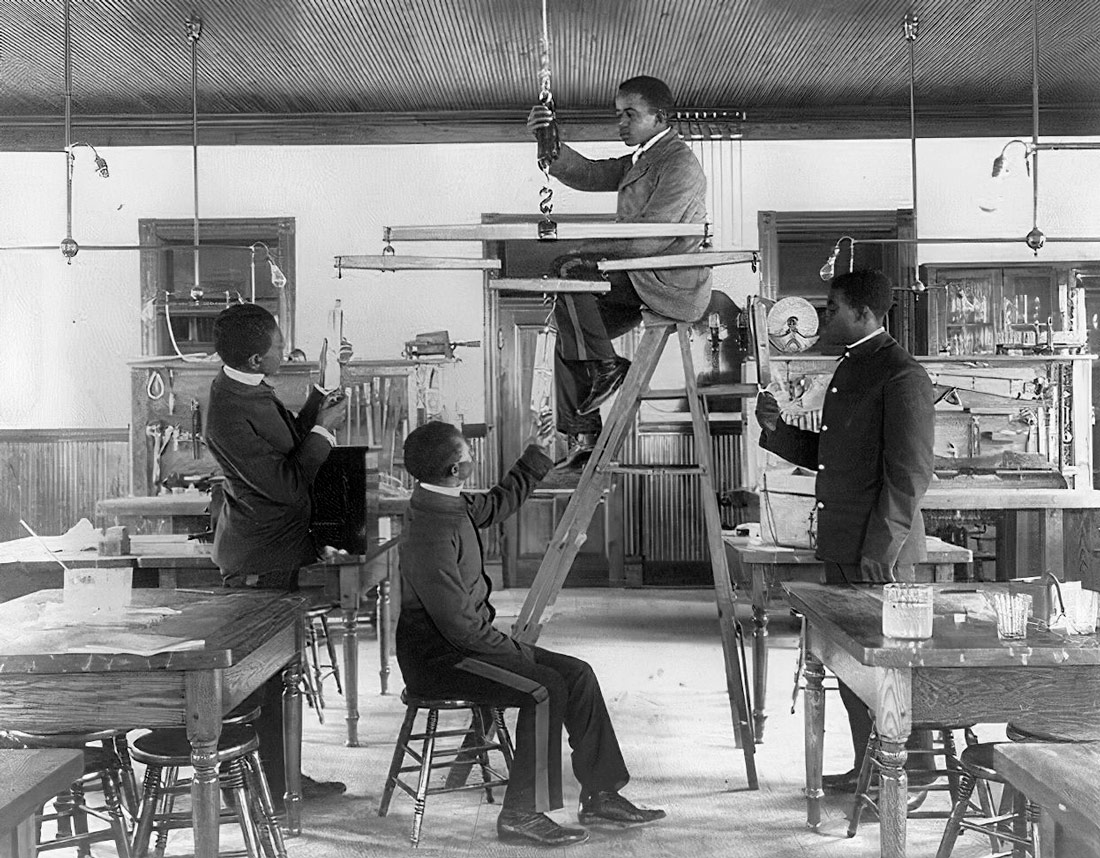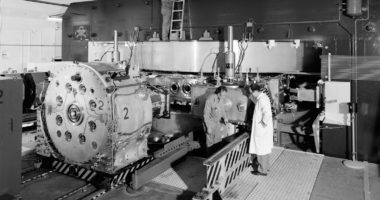
Testintg combined draught of animals. Hampton Institute, Virginia 1899 | Frances Benjamin Johnston, Library of Congress | Public domain
Although modern science has brought about notable achievements, these innovations have impacted society to varying degrees, often accelerating processes of marginalisation and perpetuating power relations. The politics of medical patents, the process of economic delocalisation and the lack of access to information technologies are examples that reflect these marginalised worlds. Critical physics is an invitation to rethink how the advances of modern science intertwine with these hierarchical and exclusionary practices.
More than just the rejection of papal authority, the Lutheran Reformation (that is to say, the 16th-century Christian movement that challenged the religious and political power of the Catholic Church) was fundamentally opposed to the Nicene Creed (or “confession of faith”). Proposed and approved in the context of two important ecumenical councils, the First Council of Nicaea in the 4th century and the Council of Chalcedon in the 5th century, the Nicene creed defended the divine nature of the Son of God. With the abandonment of this principle, one of the most mystical in Christianity, by what would go on to become Protestant societies, the first page was written in the story of the centralisation of human beings’ rational capacities, which would eventually fill the void left by this shift away from the more mysterious confessions of faith. Throughout the sixteenth and seventeenth centuries, this early supremacy of human rationality laid the foundations for a historical process known today as the Enlightenment, characterised by the supposed uniqueness and exceptionality of human reason, which is placed at the centre of fundamental debates about nature, morality, freedom, rights and equality. The expansion of the textual fruits of this occurrence within the confines of Europe was furthered by the arrival of modern information vectors such as the printing press, introduced in the 15th century by Johannes Gutenberg in Mainz, modern-day Germany, the heart of the Lutheran reformation. By the 18th century, the scientific method, a language intimately linked to this blind faith in human rationality and based on a rigid codification of observation and experience, was consolidated as a universal system of access to the genesis of the cosmos.
The origins of classical physics and mechanics are to be found in the projection of a bifurcated image of nature, in other words, the claim that reality is divided into two parts: that which derives from human subjectivity and that which is natural and hence lies beyond the limits of the social fact. To use the terms employed by Whitehead, “the dream” and “the conjecture,” since that which exists beyond the limits of the human person can never be fully known, but only supposed. Physics offers itself as a means by which we can explain this separated nature of the human subject. More specifically, classical physics responds, among other things, to three main philosophical developments. First, in the 17th century, following the Euclidean geometric system, Descartes, who would also be credited with laying the foundations of this dualistic ontology that separates human subjectivity/mind and matter/nature, laid out a system whereby each point on a plane can be specified by two coordinates. These result from drawing a straight line from a single point to the coordinate axis (x, the horizontal coordinate line; y, the vertical coordinate line). Secondly, between the late-17th and early-18th centuries, Newton developed a definition of space-time that would be a decisive step in laying the foundations of classical mechanics. For the English physicist, both time and space are universal and absolute concepts. For its part, time is linear and uniform, independent of the events of the world, while space is conceived as an empty canvas wherein resides all that which is material. Thirdly, in the 18th century, Hume, following Newton, rooted the scientific method in the assumption that experience (that which is empirical) leads deterministically to the relationship of cause and effect. These three interventions constitute what Denise Ferreira Da Silva has often described as the triad on which the Science of Man is based: separability, sequentiality and determinism. Thus, the genealogy of classical mechanics contributes to a linear, progressive and teleological way of understanding and being in the world. As Michelle Wright explains in detail, Newton’s laws of motion and gravity correlate with a narrative of linear progress that is intrinsic to the Enlightenment and the projection of the Western imaginary. The author reviews how Newtonian physics provided the philosophers and scientists of the day with a relatively simple, but compelling, understanding of space-time through which they could interpellate Europe as the vanguard of civilisation.
In his renowned critical analysis of the early 20th century, the Soviet physicist Boris Hessen points out how Newtonian science served the interests of the State, such as improved communications, shipping and trade; industry, mainly mining and metallurgy; and military technology. According to Hessen, figures such as Da Vinci, Galileo, Kepler and, above all, Newton, reduce these questions of State to mechanical problems, which are skilfully resolved in order to amplify their political and socio-economic implications. For the Soviet philosopher, there is an indisputable link between the demands of the British empire, particularly of the emerging industrial middle class coming to power, and the agenda of classical physics. Hessen helps to demystify modern science as a complex and impenetrable achievement unconnected to the social sphere. However, as the physicist himself argues, not only was Newton not an isolated scholar detached from worldly matters, but he positioned himself quite notably at the centre of the physical and technical problems of the State interests of his time. In this way it can be said that Newtonian physics reinforced the incipient stages of devastating political projects such as the colonial event, which became unconditional for the progression of an unbridled extractive capitalism and consolidated a world economic system based on relations of submission.
The advent of modern physics, and in particular the quantum revolution, also brought with it problems of exclusion at different levels. Beyond the well-known dehumanising effects of the new physics in areas such as nuclear physics through the design and subsequent detonation of the atomic bomb, there are more subtle elements of quantum history that reveal practices of displacement and nullification similar to those described in the case of classical physics. For example, if we look at the construction of the quantum narrative, this has been paradoxically linear. In other words, the emergence of quantum theory is presented in scientific circles as a European process that began at the end of the 19th century with Planck and was culminated by Heisenberg in 1925 on the island of Helgoland. This narrative exercise omits the achievements of other systems of knowledge which, although far from being described as quantum, arrive at conceptual frameworks that resemble those of quantum mechanics. These include the ancient Egyptian concepts of Duat, Ka and Kebechet and their resemblance to the principle of wave-particle duality; mathematical descriptions of the Ifa system, practised by the Yoruba in sub-Saharan Africa, which arrive at results conceptually similar to the calculations of quantum functions connecting waves and matter; and the yin-ultron and yan-ultron particles described in Confucian philosophy, the definition of which can be read as the function of strings in string theory. In this sense, what we understand as quantum is perhaps not so much the fruit of a linear sequence of events, which gives rise to a poetics that is essentially very un-quantum, but of complex interweaving flows of knowledge and practices that transcend a constrictive and exclusionary conception of space-time.
Moreover, at present, we live with a constant series of situations where quantum mechanics is instrumentalised for the purposes of dispossession and suppression. In the field of Artificial Intelligence, quantum computing, which replaces classical binary coding with sophisticated mechanical structures that allow the manipulation of quantum states, has the potential to accelerate the speed with which information is shared to exponential levels (in quantum computing, the so-called Qbits). This fact is of key relevance for the design of quantum algorithms with the hypothetical capacity to solve large sets of functions at a much higher speed than in classical computing and therefore push back the boundaries of AI even further. However, an effort must be made to re-politicise these technical and scientific innovations. As Joy Buolamwini points out, AI applications such as facial analysis technologies rely on the recognition of common patterns through the algorithmic coding of large datasets. To teach a machine to detect a face, machine learning techniques are used to analyse large amounts of data on human faces, and with time, machine learning can be modelled to detect the human face. However, as shown by numerous recent studies, if the database is not diverse, these technologies produce highly biased and exclusionary results that discriminate against certain groups, in this case, non-white women.
In conclusion, critical physics invites us to reconsider the milestones of techno-optimism, supposedly obtained through a rigorous and neutral scientific process, as an inseparable component of the social sphere. It is thus possible to observe, firstly, the epistemic violence produced by modern science, which displaces, obliterates or absorbs other ways of explaining the world. And secondly, if we focus on theoretical physics, it is also possible to see how scientific development is inextricable linked to practices oriented towards the construction of exclusionary worlds based on relationships of subordination. As Albert Kropp’s train car companion dryly remarks when returning wounded from one of the deadliest fronts of the First World War: “What good has all this science done if we have not been able to avoid this?” Questioning the scientific desire to understand the cosmos as a whole, David Bohm refutes the possibility of reducing reality to a set of rigid, deterministic laws and describes “the qualitative infinity of nature,” which is inexorably diluted by new processes and thus continually displays new, elusive qualities. In this vein, critical physics strives to contribute to the de-sedimentation of the edifice of modern science and to open the door to a multiplicity of ways of being, doing and understanding.





Rosa Maria oliva | 15 February 2024
Important és veurà que arribem a una multiciplitat de ser , fer i entendre i acceptar ho,
així veig un futur esperançador dins del diàleg i respecte de totes les diferències que ens envolten i progressen d’ una manera lineal, exponencial parabòlica ment, tal s’hi val, peró que hi són.
Leave a comment